Cottontail rabbits (Sylvilagus floridanus) have long been one of the most popular game species across rural Missouri (Figure 1). Cottontails are also common in urban and suburban areas. They have the capacity to produce several litters of young in a year, which helps cottontail populations grow quickly in areas with suitable habitats.
There are two rabbit species in Missouri. The eastern cottontail is most common and is found across the state. The larger swamp rabbit (Sylvilagus aquaticus) lives only in the Bootheel area in the southeastern part of the state. Although many people refer to both as cottontails, they are two distinct species.
This publication describes how landowners can create habitat that will attract cottontails to their property.
 Figure 1
Figure 1
The cottontail rabbit (Sylvilagus floridanus) is a popular game species in Missouri.
Breeding and biology
In March, when the weather begins to warm, male cottontails (bucks) start looking for females (does) to begin mating. The breeding season lasts through the summer. Cottontails can produce young relatively fast and typically have three to four litters each breeding season.
Near the end of the 28-day gestation period, the doe selects a well-drained location for the nest. Cottontails usually nest in old fields, open woodlands or gardens, and sometimes even in open lawns. The doe scrapes out a shallow nest cavity about 5 inches wide and 7 inches long. She lines the nest cavity with layers of grass, leaves or small roots, which will later be topped with fur pulled from her underside (Figure 2). The doe will generally build a new nest for each litter.
A cottontail may have up to nine young in a litter, but the average litter size is three to four. At birth, the young weigh about an ounce and are blind, deaf and helpless. After a week, they are completely furred and their eyes and ears open. They leave the nest 13 to 16 days after birth, when they are strong enough to fend for themselves.
A doe can breed again the day her litter is born. Some of the year's young, the juveniles, will breed the same year they are born, but most will breed for the first time the following spring.
 Figure 2
Figure 2
The doe scrapes out a shallow nest cavity and lines it with grass, leaves or small roots, and later with tufts of fur.
Habitat requirements
Cottontail rabbits prefer areas of early successional vegetation, which provides a good source of food and cover. A good rabbit habitat provides an essential mix of native warm-season grasses and a variety of herbaceous broad-leaved plants (forbs) for food, and dense underbrush, shrubs and low-growing vines for escape cover. Rabbits thrive in areas such as old home sites, broomsedge fields, overgrown fence rows, sumac and blackberry thickets, brush piles and hedgerows (Figure 3).
Agricultural areas with small crop fields surrounded by brushy, herbaceous fence rows and field borders of thickets, native grasses and forbs are excellent places to find rabbits. Changing land-use practices — particularly the conversion of small, diverse agricultural fields to large, weed-free single-crop fields — have resulted in declining cottontail populations.
Cottontails eat a variety of plants, including grasses, sedges, succulent sprouts of new plant growth, leaves, fruits, buds and bark. During the summer, cottontails will forage for available plant vegetation, including grasses, legumes, succulent annuals, weeds and, if a garden is nearby, fruits and vegetables. Their winter diet includes small grains, clovers, and bark and buds of shrubs and trees. In agricultural areas, they also eat corn and soybeans, two high-energy foods.
Cottontails require diverse vegetation and protective cover within their home range to escape predators. These requirements are similar to those of bobwhite quail, so managing your land for rabbits may also attract quail. Rabbits are fair game for nearly all predators, so suitable escape cover is crucial. Bare ditch banks; clean fence rows; recreational mowed landscapes; small patches of grasses; large, overgrazed cool-season grass pastures; and cultivated fields do not qualify as rabbit habitat.
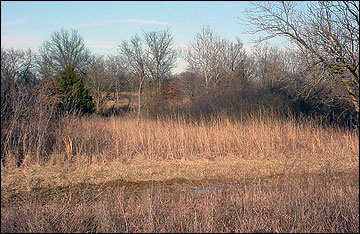 Figure 3
Figure 3
Brushy cover provides escape from predators and is an important habitat component for rabbits.
Rabbit habitat management practices
Rabbit habitat can be improved through a variety of management practices that can be integrated with ongoing land use activities. A cottontail may spend most of its life on one acre or less, so you don't need to devote large areas of land specifically to rabbit habitat. Managing field borders, unproductive cropland and old fields can greatly increase the number of rabbits on your property.
Identifying the limiting factors, or habitat components in short supply, will help you determine which management practices will be most likely to increase the rabbit population on your property. Lack of escape cover is often the most limiting factor. This section discusses cover development and other management practices that can benefit cottontails.
Establishing and managing field edges
An easy way to grow early successional vegetation on your property is by creating or improving areas of vegetation between two habitat types — such as between a crop field and pasture. These areas are often referred to as "transition zones" and may be developed along an adjoining edge between pastures, fence rows, roads, ditch banks, woodlands or cultivated fields (Figure 4).
Transition zones may be established in unproductive field corners, edges or along adjacent field borders. These zones may be located where woodlands meet crop fields or pastures and along fence rows and roads. Establishing transition zones is perhaps the easiest and cheapest rabbit management practice in agricultural areas because you can just let nature take its course to allow plants to grow from bare ground to weedy vegetation and on to shrubby thickets. In agricultural areas, create transition zones by establishing and managing a field border of native warm-season grasses, forbs and shrubs around a crop field or by conducting edge feathering along the woodland border of a crop field or other type of habitat (Figure 5).
To maintain these transition zones in herbaceous vegetation — legumes, grasses and forbs — you should conduct some type of disturbance every three years. Examples of a disturbance include prescribed burning and strip disking, preferably conducted during the winter or early spring (Figure 6).
In addition to establishing transition zones along field edges, you can improve rabbit habitat in larger crop fields or pastures by creating travel routes into unused areas. Rabbits will not generally venture far into open areas away from escape cover or areas that provide food. Create travel lanes in larger fields by dividing them into smaller tracts of 20 to 30 acres, leaving undisturbed strips of native vegetation that provide both food and shrubby cover. These strips should be at least 60 feet wide — wider, if practical. Set them up to connect to woodlands, crop fields, pastures and other areas that provide good cover. Maintain the strips by disking or burning one side of each strip every two or three years in the early spring. Brush piles or other suitable escape cover positioned randomly throughout these strips will greatly increase rabbits' use of the area.
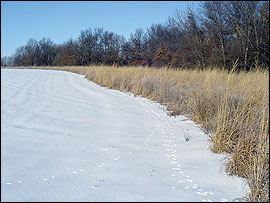
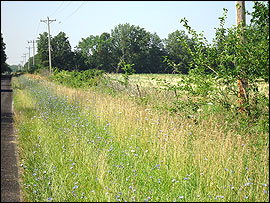
Figure 4
Transition zones are habitats that provide a mix of food and can be created within fields or along the edges of fields and fence rows.


Figure 5
Transition zones around woodland or agricultural areas may be created by edge feathering or establishing an area of downed trees or a stand of shrubs, native grasses and forbs.
 Figure 6
Figure 6
Strip disking is an example of a disturbance that will encourage growth of new vegetation to improve rabbit habitat.
Developing food sources
Good habitat provides food as well as cover. Many native herbaceous plants, such as those listed in Table 1, are found in early successional habitats and will respond after a disturbance. Food sources can also be established by planting food plots. For example, quarter-acre food patches or strips can be planted beside escape cover, particularly during the winter months when native foods may be in short supply. If food scarcity is an issue, provide a quarter-acre food plot for every 2 to 5 acres being managed for rabbits. White, red and crimson clover and green succulent vegetation, such as alfalfa, winter wheat, rye, winter peas and grain crops, provide supplemental foods during winter and spring (Figure 7). Seeding rates for these crops can be found in publications listed in the Additional information section.
Table 1. A selection of important food plants for rabbits.
- Asters
- Bluegrass
- Cheatgrass
- Cinquefoil
- Clovers
- Crabgrass
- Crop residues
- Dandelion
- Fall panicgrass
- Fleabanes
- Horse nettle
- Knotweed
- Nodding foxtail
- Plantains
- Poison ivy
- Ragweeds
- Sedges
- Smartweeds
- Strawberry
- Korean lespedeza
- Sumacs
- Tall thistle
- Tick trefoils
- Timothy
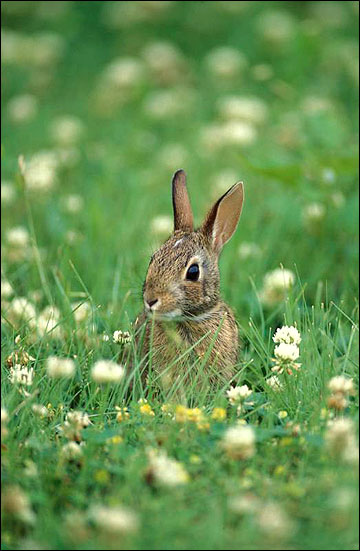 Figure 7
Figure 7
Legumes such as clover and alfalfa provide excellent supplemental food sources for cottontail rabbits.
Developing cover
Quality escape cover provides a vegetation barrier that is extremely difficult for predators to move through. Escape cover should be protected from grazing and other disturbances, such as frequent mowing. Fencing off woodlots and pond areas to exclude livestock can improve existing cover and allow grass and shrubs to become established.
Dense, well-distributed protective cover is the most crucial element of a good rabbit habitat. More than other management practices, placing shrubby wild plum thickets, blackberry patches and downed brushy structures in the right places can help rabbit populations thrive on your property (Figure 8). Rabbits will often use these habitats as soon as they are developed.
As discussed earlier, edge feathering can be conducted in woodlands next to crop fields or pastures to improve escape cover for cottontails. Some trees, such as pin oak or shingle oak, will remain alive for several years when hinge-cut at the stump. To hinge-cut a tree, cut a portion of the trunk and fell the top over while it is still attached to the stump. The live limbs of hinge-cut trees can provide both food and cover for several years (Figure 9).
Additionally, properly constructed brush piles can be placed beside existing natural woody cover such as briars, fence rows or woodland edges (Figure 10). Brush piles are fairly cheap and easy to build where shrubby cover is nonexistent. They provide cover that cottontails will use immediately. Using a variety of woody debris, pile materials 5 to 6 feet high and at least 10 to 20 feet wide. This type of cover should be created at intervals of 100 yards or so. Try to keep about 10 to 15 percent of grassy fields, cropland field edges or upland forests in scattered shrubs, thickets or brush piles for cover.
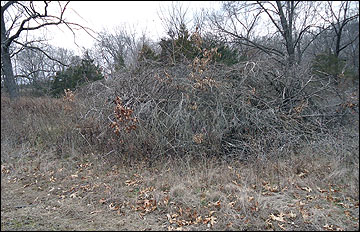 Figure 8
Figure 8
The protective escape cover provided by brushpiles and thickets is an important habitat component for cottontail rabbits.
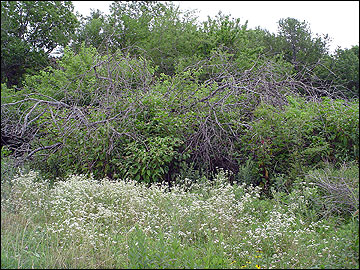 Figure 9
Figure 9
A combination of shrubs and hinge-cut live trees along fence rows or field edges provides protective escape cover.
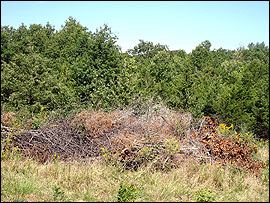
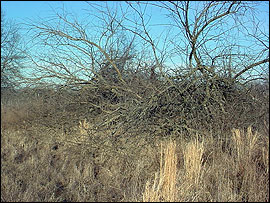
Figure 10
Brush piles constructed near food sources provide escape cover readily used by cottontails.
Managing plant succession
Prescribed fire
Prescribed fire is an effective management tool that improves nutrition and availability of plants used for food and the quality of habitats for rabbits by setting back plant succession. Prescribed fire in fields, grasslands and open woodlands encourages the growth of native annual plants, such as ragweed, partridge peas, native lespedezas and many other native forbs.
One technique that has proven successful is to develop a patchwork of burned and unburned areas in a field to maintain a mix of annual and perennial plants. Divide fields or grasslands into strips or patches with disked firebreaks, and conduct a prescribed fire within each strip every three to four years. The burned areas provide nutritious forage, and the unburned areas provide cover.
Seek professional advice from a wildlife biologist, forester or private land conservationist with the Missouri Department of Conservation (MDC) before conducting a prescribed fire. They can give you advice on the best time of year to burn and help design a burn plan to achieve your management objectives.
Disking
Disking is an excellent management practice for promoting the growth of annual grasses and forbs. It can be done in areas where a prescribed fire may not be recommended. Light disking that incorporates about half of the existing plant residue can stimulate the germination of annual plants in the seed bank.
As with prescribed fire, disking 30- to 60-foot-wide strips every two to three years provides areas for annual grasses and forbs to germinate, and leaves undisturbed areas that provide escape cover. Alternate which areas are disked and which are left undisturbed so light disking is conducted across the entire area once every two to three years — this practice is called rotational disking.
Disking should be conducted along the contour of the land to minimize erosion. Fall and winter are the best times to disk. Fall disking promotes germination of forbs and legumes the next year; disking later in the year tends to promote grass germination.
Selective use of herbicides
Herbicides can be used to renovate and restore wildlife habitats. Nonnative turf grasses, such as tall fescue, can be controlled with a combination of prescribed fire, disking and the use of recommended herbicides. Glyphosate-based herbicides are usually recommended to control tall fescue. Apply treatments to tall fescue during the fall, and reapply the next spring. Each situation is different and no single herbicide recommendation will be effective, so seek advice on herbicides and their proper application techniques from an experienced natural resource professional, an MDC private land conservationist or MU Extension.
Woodland and forest management
Thinning and timber stand improvement practices can improve the quality of the remaining trees and habitats for rabbits on tracts of woodland and forest. These practices open the canopy and allow more sunlight to reach the ground, which enhances the growth of grasses and forbs. To improve a habitat, you can also create temporary or permanent forest openings of a quarter acre to an acre. These areas can be maintained by rotational disking, prescribed fires or alternating strips of food plot plantings. For more information on woodland and forest management practices for cottontail rabbits and other wildlife, see the resources listed in the Additional information section.
Limiting factors affecting rabbit populations
Rabbits are prey to a variety of mammals and birds. Foxes and coyotes are generally their most common predators, followed by bobcats. Hawks and owls will prey on rabbits; rabbits may account for up to 40 percent of a great horned owl's diet at certain times of the year.
Additionally, rabbits' nests may be destroyed by a variety of predators, including coyotes, crows, dogs, feral cats, foxes, hawks, minks, owls, snakes, skunks and weasels. Although most rabbits will not live longer than a year and losses to predators can be high at certain times of the year, rabbits produce many offspring and can maintain good populations if suitable habitat is available.
Cottontails are susceptible to a variety of diseases and parasites, some of which can be deadly. Diseases and parasites are common in most wild species and are generally insignificant, but hunters and cottontail enthusiasts should be aware of some of them. Though most cause the rabbit little harm, some are responsible for the needless waste of hundreds of pounds of rabbit meat each year.
Probably the best known or most obvious cottontail afflictions are wolves, warbles or bots. These terms are used to describe fly larvae that look like grubs and are found under the skin of infected rabbits, generally on the neck and chest. Wolves, as they are commonly called, are larval stages of certain fly species. The adult fly lays eggs on the hair of the rabbit. When the eggs hatch, the larvae bore into the skin. These larvae grow to about 1½ inches long, at which time they will emerge from the rabbit's skin, fall to the ground, bore into the soil, pupate and later emerge as adult flies. These parasites are more abundant during warmer weather and are generally gone from infected rabbits by late fall or early winter. Rabbits rarely die from this infection, and the meat is edible if larvae are removed and the meat well cooked.
Fibroma disease, or rabbit horn, is a virus that causes black growths to form on the skin of cottontails. This warty-looking growth is normally confined to the skin and is usually removed along with the hide. Infected rabbits can be safely handled, cleaned and eaten. The virus is spread by ticks, mosquitos, biting flies and other biting insects.
Tularemia, or rabbit fever, is the most important and deadly disease affecting cottontails. The organism responsible for the disease, a bacterium called Francisella tularensis, is capable of infecting a number of wild birds and mammals, including humans, but more commonly occurs in rodents and rabbits. Dense rabbit populations are especially prone to tularemia infections, and the disease can quickly decimate a local population. Infected rabbits die within a week to 10 days after the onset of the illness. Signs of the disease in rabbits include sluggishness, slow reactions and refusal to run. In advanced stages, internal organs, such as the lungs, liver and spleen, may be covered with small white spots. Positive diagnosis of tularemia requires laboratory work by disease experts.
Humans are susceptible to tularemia, and though there are currently no vaccines to prevent the disease, tularemia responds quickly to antibiotics.
Several steps can be taken as added protection against tularemia:
- Hunt rabbits after the onset of cool weather when chances are most infected rabbits have died.
- If a rabbit shows no natural wariness or alertness and no strong inclination to run, don't bag it. Sick rabbits are often sluggish and "tame."
- Avoid getting rabbit blood on your hands.
- Always wear rubber gloves when dressing rabbits, even in winter.
- After removing your rubber gloves, wash your hands well with strong soap and hot water if available, and treat all cuts, scratches and abrasions on your hands with iodine. This step can be taken in the field as well as at home.
- Cook rabbits thoroughly. Never eat rare or undercooked rabbit.
Cottontail hunting and harvest
Rabbit populations can usually withstand heavy hunting pressure. Rabbits, like quail and most other small game, have a high annual turnover rate — up to 80 percent of the population each year — which occurs regardless of whether they are hunted. In other words, you can't stockpile rabbits no matter how many the land can support. If hunters do not remove the annual surplus, then weather, disease, parasites, predators or starvation will. Normally, up to 65 percent of the fall rabbit population may be taken without affecting the spring breeding population.
Conclusion
Most farms in Missouri have ample room for large cottontail populations. Managing for cottontail rabbits also provides habitats for bobwhite quail, songbirds and many other wildlife species. In some situations, landowners have invested in managing habitats for bobwhites and seen no quick response in covey numbers, whereas rabbit populations increased dramatically. Rabbits and bobwhites need similar habitats: an appropriate mix of well-distributed escape cover, an ample year-round food supply, and a safe place for nesting and raising young. Although rabbits use water sources, they also obtain water from the succulent plants they eat.
Begin by developing a wildlife management plan for your property. Work with a wildlife biologist who can help you identify affordable habitat management practices. You may be eligible for certain conservation programs that provide financial incentives to implement management practices. Contact your local MU Extension center or a wildlife biologist with the Missouri Department of Conservation, or the USDA Natural Resources Conservation Service for additional information on conservation programs and managing habitats for wildlife.
Additional information
Refer to these Missouri Department of Conservation resources to learn more about cottontail rabbits and how to manage your land for them.
Photo credits
Robert Pierce, Nick Prough and the Missouri Department of Conservation.